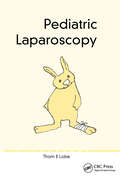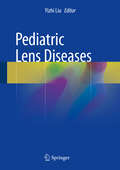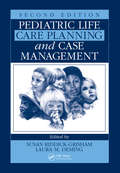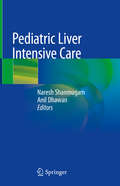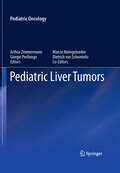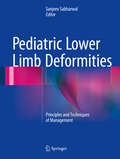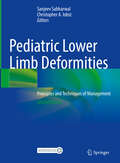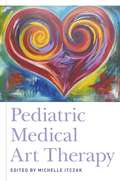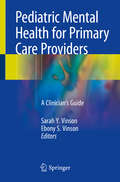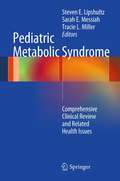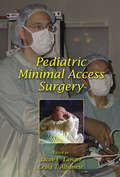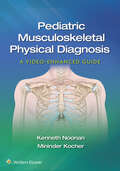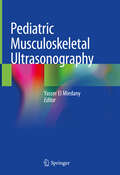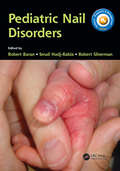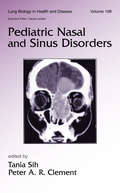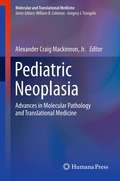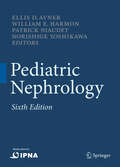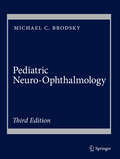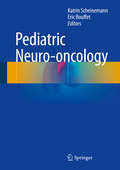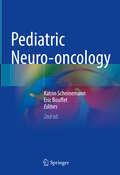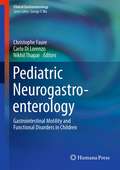- Table View
- List View
Pediatric Laparoscopy
by Thom E LobeSince pediatric surgeons can and do perform nearly every major pediatric surgical procedure laparoscopically, and since many of the approaches have evolved some over the years—past the learning curve—into cost effective operations that rarely take extra time to perform, or in some cases save time, it is worthwhile reviewing our current practices. This book, then, serves as both an update of current practices and as a manual for how to approach the most common of the pediatric disorders using laparoscopic techniques. It covers the basics of anesthesia, instrumentation and ergonomics and then reviews many of the more commonly performed laparoscopic and thoracoscopic pediatric procedures, including a review of fetal work. While any book written about such a rapidly evolving technique may miss some of the very newest twists and modifications of technique, it is our hope that most of the contents will serve the readers as a reference for years to come as they care for children with common pediatric surgical problems.
Pediatric Lens Diseases
by Yizhi LiuThis book focuses on disorders of the lens, which are a major cause of blindness in children. During development, children's eyes have unique physiological and structural characteristics, such as an immature blood-aqueous barrier, which presents considerable challenges for ophthalmologists involved in the diagnosis and treatment of pediatric lens disorders. Throughout the book, the pathology, examination, anesthesia, surgical treatment and nursing care of pediatric lens disorders are discussed in detail. It not only presents diverse pictures and images from clinical practice, it also includes the latest findings in the field. It will be of interest to ophthalmologists and paediatricians looking to improve the diagnosis and treatment of pediatric lens disorders and provide a valuable reference resource for all those involved in ophthalmic clinical practice, teaching and research.
Pediatric Life Care Planning and Case Management
by Kate M. Grady Andrew M. Severn Paul R. EldridgePediatric Life Care Planning and Case Management provides a comprehensive and unique reference that goes beyond the clinical discussion to include legal and financial aspects, life expectancy data, and assistive technology. It also includes case samples of actual plans related to specific conditions. The book is divided into five parts: Normal Grow
Pediatric Liver Intensive Care
by Anil Dhawan Naresh ShanmugamAcute management of children with liver disease and liver transplantation has rapidly evolved over the last two decades due to worldwide availability of complex liver surgery and liver transplantation. This book edited by Prof Dhawan and Dr Shanmugam, who have hands on experience in managing children with complex liver disease, its complications and liver transplant recepients, provides to a very practical approach to all the team members involved in paediatric transplantation like ; Hepatologists, anaesthetists, surgeons, intensivists, transplant coordinators, nurses and trainees at all levels and specialities. Topics covered include management of common liver problems, liver based metabolic disorders and peri-operative care protocols in paediatric liver transplantation. It also provides up to date information on drug dosage and infusion calculations for common drugs used in liver disease.
Pediatric Liver Tumors
by Arthur Zimmermann Dietrich Von Schweinitz Giorgio Perilongo Marcio MalogolowkinThe field of liver tumors in children has seen tremendous therapeutic advances over recent years. This has been achieved through a much better understanding of the biology of disease, improved diagnostic procedures, refined methods of pretreatment tumor staging, the implementation of highly efficient chemotherapy and surgery, detailed monitoring of toxicity, and careful follow-up strategies. International controlled trials have played a key role in these advances, and many leading figures in the trials are among the editors and authors of this book. Their principal goal in Hepatic Tumors in Children is to provide the reader with a complete update on this complex and rapidly evolving field. All aspects of an impressive success story are covered, disclosing how the outcome of a previously devastating disease has been so dramatically improved. This book will prove essential reading for all who are involved in the care of children with liver tumors.
Pediatric Lower Limb Deformities
by Sanjeev SabharwalComprehensive and generously illustrated, this text highlights both general principles and specific strategies for managing the spectrum of pediatric lower limb deformities. It is divided thematically into five sections, though any chapter can stand on its own to guide the clinician in specific situations. Part I covers general principles and techniques, including etiology, clinical evaluation, imaging as well as different surgical methods. Part II, covering related concepts and management options, discusses soft tissue contractures, amputations and working in austere and resource-challenged settings. Underlying conditions comprise part III - specific metabolic, neuromuscular and tumor-related conditions, along with arthrogryposis, Osteogenesis Imperfecta and various skeletal dysplasias. Part IV presents congenital and developmental disorders, such as congenital femoral deficiency, hemimelias, tibial pseudoarthrosis and Blount disease, while part V rounds out the book with chapters on sequelae related to different etiologies and their treatment. Covering all aspects of the management of pediatric lower limb deformities and written by renowned experts in the field, this textbook will be an invaluable resource for orthopedic surgeons and trainees worldwide.
Pediatric Lower Limb Deformities: Principles and Techniques of Management
by Sanjeev Sabharwal Christopher A. IobstNow in a completely revised and updated second edition, this comprehensive and generously illustrated text highlights both general principles and specific strategies for managing the spectrum of pediatric lower limb deformities. It is divided thematically into five sections, though any chapter can stand on its own to guide the clinician in specific situations. Part I covers general principles and techniques, including etiology, clinical evaluation, imaging as well as different surgical methods. Part II, covering related concepts and management options, discusses soft tissue contractures, amputations and working in austere and resource-challenged settings. Underlying conditions comprise Part III – specific metabolic, neuromuscular and tumor-related conditions, along with arthrogryposis, osteogenesis imperfecta and various skeletal dysplasias. Part IV presents congenital and developmental disorders, such as congenital femoral deficiency, hemimelias, tibial pseudoarthrosis and Blount disease, while Part V rounds out the book with chapters on sequelae related to different etiologies and their treatment.New to this edition is the inclusion of invited commentary from additional experts, adding further context and clinical pearls. Additionally, ten new chapters have been added, including some that are completely rewritten by different authors and other chapters that cover new themes such as patient reported outcome measures, setting up a limb deformity practice, pin site care and management of bone defects.Covering all aspects of the management of pediatric lower limb deformities in different practice settings, and written by internationally renowned experts in the field, this new edition of Pediatric Lower Limb Deformities continues to be an invaluable resource for orthopedic surgeons and trainees worldwide.
Pediatric Malignancies: Pathology and Imaging
by David M. Parham Joseph D. Khoury M. Beth MccarvillePediatric tumors comprise a unique set of diseases that may pose diagnostic challenges to pathologists, oncologists, and pediatricians. Pediatric Tumor Pathology: A Practical Approach serves as a state-of-the-art reference for understanding the fundamental biology and diagnostic aspects of pediatric tumors. This volume stands apart from other books covering pediatric neoplasia by providing an in-depth analysis of the pathogenetic and diagnostic aspects of the most commonly encountered tumors. The volume covers the new advances in our understanding of the molecular processes underlying a number of pediatric tumors and the novel, sophisticated diagnostic tools that have now become an integral part of practice standards. Pediatric Tumor Pathology: A Practical Approach will be of great value for many practicing clinicians and pathologists for characterizing and diagnosing childhood tumors. Oncologists, radiologists, surgeons and pediatricians will also find this book a unique and valuable resource for understanding the biological and diagnostic aspects of pediatric tumor pathology.
Pediatric Maxillofacial Trauma
by George M. Kushner Lewis C. JonesThis book aims to assist the reader in navigating the potentially complex decision-making process involved in selecting the most appropriate intervention for each particular scenario that may be encountered by the practitioner or surgeon in the growing patient with facial trauma. Among the topics covered are the initial management of both soft and bony trauma, including different types of fracture, as well as the management of complications and revision surgery. The discerning practitioner will learn how to provide the appropriate intervention at the appropriate time, by taking into account skeletal growth when matching techniques to the injuries more common in the skeletally immature patient. It is also emphasized that in some cases, no intervention is advisable owing to the possibility of damaging growth centers or introducing additional scar tissue that may impede future growth. Pediatric Maxillofacial Trauma will provide key knowledge for surgeons treating growing patients, ensuring that their decisions to operate or delay intervention are evidence based.
Pediatric Medical Art Therapy
by Tracy Councill Kayleigh Orr Andrea Davis Nana Zhvitiashvili Julie Gant Anna Moore Megan Belcher Abbien Crowley Ciucci Josephine Mahoney Aimee O'Neill Kristen CatchpoleArt therapists have an essential part to play in supporting children and their families when a child is undergoing medical treatment. The art therapists who contribute to this book offer their experience of working in medical environments and creating hospital art therapy programs for working with children and young people. Readers will find interventions and techniques, along with program development ideas and diverse approaches to work with patients. Chapters also cover different diagnoses and areas of healthcare, such as oncology, chronic illness and burns. The challenges and opportunities for art therapy in working with terminal illness and bereavement are also addressed. Pediatric Medical Art Therapy delineates the essential considerations and lessons for the art therapist who joins the medical journeys of children and their families, and emphasises the importance of this unique role.
Pediatric Mental Health for Primary Care Providers: A Clinician's Guide
by Sarah Y. Vinson Ebony S. VinsonThe purpose of this book is to provide a children’s mental health resource tailored to the needs of physicians working with children. There are currently no such texts, despite the fact that there are patient care, healthcare systems, and workforce factors that indicate a strong need for such a resource. Approximately 1 in 5 children are diagnosed with a mental illness by the age of 18. Additionally, mental health conditions, including Attention Deficit Hyperactivity Disorder, are consistently among the most common chronic conditions in pediatric clinical populations. Delays in both diagnosis and treatment increase the morbidity associated with these conditions. These delays expose the child to negative ramifications of his/her illness and can impact rates of poor academic performance, substance use disorders and criminal justice system involvement – potentially impacting long-term life trajectories. Early identification of mental illness and appropriate intervention is critical to the healthy development of youth, though physicians in primary care and pediatrics are seldom trained to detect and treat such illnesses. The importance of recognizing mental illness is reflected in practice guidelines for pediatric primary care providers as well as in how service delivery is being structured, but this does not offer in-depth clinical guidelines. Additionally, integrated care and medical home models include mental health as key components, though yet again physicians are often not trained to work with these models. While clearly indicated clinically, these requirements do not come with significant increases in reimbursement and are added to an already demanding schedule. Increasingly, providers are also expected to use evidence based screening instruments without exposure to this body of literature. Some guidance on using those instruments in context will help them to use those tools more effectively. Finally, primary care providers and even some adult psychiatrists and psychologists are operating in a healthcare system with a severe, nationwide shortage of child and adolescent psychiatrists and mental healthcare providers. While a text certainly cannot single-handedly compensate for such a workforce shortage, it could potentially help to mitigate the negative impact on patients by facilitating early identification and treatment in the primary care setting. Additionally, with more effective treatment in pediatric settings, less complex cases may be addressed before specialty care is needed, and the expertise of child and adolescent psychiatrists can be more effectively used for more complex cases.Pediatric Psychiatry in Primary Care is the ultimate resource for clinicians working with children, including pediatricians, family physicians, general psychiatrists, psychologists, early career child psychiatrists, social workers, nurses, school counselors, and all clinical professionals who may encounter children struggling with psychiatric disorders.
Pediatric Metabolic Syndrome
by Sarah E. Messiah Steven E. Lipshultz Tracie L. MillerIn just under three decades, the world has witnessed an enormous rise in obesity with a parallel growth in cardiometabolic disease risk factors characterized by insulin resistance, dyslipidemia, and hypertension, together known as the metabolic syndrome - conditions previously unheard of in children and adolescents. During this time, we have little knowledge of the global and cumulative detrimental health effects of childhood obesity. As obese children age, not only will their health be negatively affected, but infertility and pregnancy complications associated with the metabolic syndrome will affect generations to come. The work force will undoubtedly be affected because of increased sick days and decreased work productivity. Identifying children and adolescents at the earliest stages of chronic disease onset should be the goal of clinical practice, yet there is no clear guidance for defining the risk of metabolic syndrome or appropriate risk-factor thresholds in these groups. If children are identified early in the disease process, lifestyle and clinical interventions can be instituted when they are potentially more effective. Pediatric Metabolic Syndrome: Comprehensive Clinical Review and Related Health Issues approaches the pediatric metabolic syndrome by elucidating its effects on specific organ systems and by considering the problem through understanding the social, psychological and economic consequences of it. The Editors have recruited an invited group of esteemed experts in the field to provide the most timely and informative approaches on how to deal with this health crisis. Through educating our practitioners, our future researchers, our health and community organizations, our legislators and our families and children, we have the best chance at improving the health trajectory of the next generation.
Pediatric Minimal Access Surgery
by Jacob C. Langer Craig T. AlbaneseThis authoritative guide reviews the evoloving evidence-based literature for a wide variety of procedures and techniques in pediatric minimal access surgery (MAS)-providing expertly-written chapters that cover the techniques specific to a broad range of diseases, as well as current advances in urology, neurosurgery, and spinal and cardiac surgery.
Pediatric Musculoskeletal Infections: Principles & Practice
by Martin J. Herman Mohan V. Belthur Ashish S. Ranade James A. FernandesPediatric musculoskeletal infections are common globally and represent about 1-2% of all pediatric hospital admissions in the developed world and about 10-20% of admissions in the developing countries. If untreated or treated inadequately, pediatric bone and joint infections can cause significant mortality and morbidity. The functional and economic burden to the family and community at large also presents a significant public health problem.This book serves as an evidence-based, comprehensive review of the current concepts for the early diagnosis and management of pediatric musculoskeletal infections. Currently, there are no comprehensive, easily accessible books on this topic. This first of its kind book also uses a multidisciplinary and global approach by including contributions from editors and authors worldwide. The long-term goal of this text is to help improve the quality of care provided to children with musculoskeletal infections improve patient safety, reduce the cost of care, and add value to the care provided to these children and thus reduce the economic burden.Broken up into five sections, the first part of this text covers the epidemiology, microbiology, pathological consequences, antibiotic therapies, systemic effects, and imaging modalities of pediatric musculoskeletal infections. Section two takes a detailed look at acute pediatric musculoskeletal infections. Infections discussed in this section include acute hematogenous osteomyelitis, septic arthritis, pyomyositis, complex musculoskeletal infections, musculoskeletal infections in the neonate and acute surgical site infection after pediatric orthopedic surgery. Section three focuses on chronic osteomyelitis and its sequelae. Section four examines anatomic region-specific considerations in musculoskeletal infections. The topics that are expanded upon are epiphyseal osteomyelitis, Pediatric hand and foot infections, tuberculosis of the axial and the appendicular skeleton, and non-tuberculous infections of the spine. Finally, the fifth section includes an overview of less common musculoskeletal conditions such as, fungal infections, brucellosis, hydatid disease, gas gangrene, viral musculoskeletal infection and meningococcal infections.Written by experts in the field, Pediatric Musculoskeletal Infections: Principles and Practice serves as an easily accessible resource for a global audience of healthcare providers from multiple disciplines to aid them in making informed decisions while managing pediatric bone and joint infections. Paediatricians, orthopedic surgeons, infectious disease physicians, radiologists, pathologists, family physicians and any other healthcare providers involved in the care of children with musculoskeletal infections will find immense value in this reference as will medical students, residents and fellows.
Pediatric Musculoskeletal Physical Diagnosis: A Video-Enhanced Guide
by Mininder Kocher Kenneth NoonanMusculoskeletal complaints represent a large percentage of cases seen by pediatricians, family physicians, and other first-line clinicians who work with children and adolescents. Pediatric Musculoskeletal Physical Diagnosis: A Video-Enhanced Guide helps health care practitioners arrive at an accurate diagnosis and determine the need for a referral. Written by leaders in pediatric orthopaedics, this practical guide is a comprehensive, multimedia resource covering the physical examination and the next steps to diagnosis of disorders of the growing musculoskeletal system. This is the tablet version which does not include access to the videos mentioned in the text.
Pediatric Musculoskeletal Ultrasonography
by Yasser El MiedanyThis book provides a comprehensive compilation of musculoskeletal ultrasonography (MSUS) fundamentals in pediatric rheumatology with emphasis on imaging techniques, normal anatomy, approaches towards standardization, and the spectrum of pathologic findings seen in the pediatric population. It examines the techniques and pitfalls of MSUS in pediatrics and compares sonoanatomy in pediatric patients versus adults. Chapters cover a range of anatomical sites, including shoulder and arm, elbow and forearm, wrists and hands, hip and thigh, knee and leg, and ankle and feet. The text also discusses the use of ultrasonography in juvenile inflammatory arthritic conditions and sports-related injuries. Finally, the book concludes with a summary of the recent advances in pediatric musculoskeletal ultrasonography. Featuring contributions from a large international group of leaders in the field, Pediatric Musculoskeletal Ultrasonography is an authoritative reference for pediatric and adult rheumatologists, sonographers, radiologists, physiotherapists, and orthopedic specialists.
Pediatric Nail Disorders (Pediatric Diagnosis and Management)
by Robert Baran, Smail Hadj-Rabia, Robert SilvermanThis is a highly illustrated guide to the diagnosis and management of nail conditions in children. With new material on genetics and on developments such as dermoscopy, it will be invaluable as a reliable clinical reference for both dermatologists and pediatricians, as well as those in family practice.
Pediatric Nasal and Sinus Disorders
by Tania Sih Peter A. R. ClementThe first and only source to offer a detailed and authoritative review of every aspect of nasal and sinus disorders in children, this reference provides an impressive collection of reviews on topics ranging from disease mechanisms and immunodefense to diagnosis, medical management, and surgical strategy.
Pediatric Neoplasia
by Alexander Craig Mackinnon JrPediatric Neoplasia: Advances in Molecular Pathology and Translational Medicine presents many of the major, relevant advances in molecular pathology that are occurring in the field of pediatric oncology and will serve as a useful overview for resident and attending physicians as well as scientists interested in understanding the molecular pathology of pediatric cancer in the context of clinical medicine. Chapters are based upon organ systems, and each is written by an expert or pair of experts in their field with subspecialty training and extensive clinical experience. Each chapter describes a variable number of tumors and includes an overview of the classification system and clinicopathological characteristics of each tumor. This is followed by a discussion of the molecular pathology relevant to a specific tumor, including specific molecular markers of the tumors, methods used for diagnosis or clinical management, clinical significance of the markers, and if appropriate, a description or discussion of current activities in translational research or issues that need to be addressed in the future. Pediatric Neoplasia: Advances in Molecular Pathology and Translational Medicine will be of great value to pathologists, oncologists, hematologists, internal medicine and pediatric specialists, as well as pharmaceutical professionals and translational and clinical researchers.
Pediatric Nephrology
by Norishige Yoshikawa Ellis D. Avner Patrick Niaudet William E. HarmonHere is an extensive update of Pediatric Nephrology, which has become the standard reference text in the field. It is global in perspective and reflects the international group of editors, who are well-recognized experts in pediatric nephrology. Within this text, the development of kidney structure and function is followed by detailed and comprehensive chapters on all childhood kidney diseases.
Pediatric Neuro-Ophthalmology
by Michael C. Brodsky"Due to the generous representation of the afferent visual system within the brain, neurological disease may disrupt vision as a presenting symptom or as a secondary effect of the disease. Conversely, early developmental disturbances of vision often disrupt ocular motor control systems, giving rise to complex disorders such as nystagmus, strabismus, and torticollis. The signs and symptoms of neurological disease are elusive by their very nature, presenting a confounding diagnostic challenge. Neurological medications and neurosurgical treatments can produce neuro-ophthalmological dysfunction that can be difficult to distinguish from disease progression. Affected patients may experience substantial delays in diagnosis, and are often subjected to extensive (and expensive) diagnostic testing. Scientific articles pertaining to specific disorders are scattered throughout medical subspecialty journals. These children continue to "fall through the cracks" of our medical education system. The increasing recognition that pediatric neuro-ophthalmology comprises a distinct set of diseases from those seen in adults has led to its emergence as a dedicated field of study. "Since the original publication of Pediatric Neuro-Ophthalmology nearly fourteen years ago, interest in the field has burgeoned. Pediatric ophthalmology and pediatric neurology subspecialty conferences often include symposia dedicated to recent advances in pediatric neuro-ophthalmology. Technical advances in neuroimaging have given rise to a more integrated mechanistic classification of neuro-ophthalmological disease in children. Our understanding of neurodevelopmental disorders of the visual system has expanded, longstanding monoliths have been dissembled into component parts, basic molecular mechanisms have taken center stage, and genetic underpinnings have become definitional. Evolutionary alterations can now be observed at the level of the gene, adding a new dimension to our understanding of disease pathogenesis. New classifications now encompass clinically disparate conditions. Descriptive definitions have been supplanted by mechanistic ones, and clinical definitions superseded by genetic ones. Our concept of disease pathogenesis has been revised and in some cases overturned. Bearing witness to these remarkable advancements has compelled me to enhance and expand the first edition of Pediatric Neuro-Ophthalmology into this new and revised one. "In the first edition of this book, our goal was to present the clinical characteristics, diagnostic evaluation, and therapeutic options for the common neuro-ophthalmologic disorders of childhood. In so doing, we designed the book to be provide a narrative journey through the thought processes involved in the clinical management of these disorders. In this edition, I have retained the basic narrative format of original book, while expanding the exploration of these complex visual disorders in the context of the many new scientific advancements and discoveries that have come to light. These conditions are fun to diagnose, fascinating to understand, and gratifying to manage." --from the Preface to the 2nd Edition.
Pediatric Neuro-oncology
by Katrin Scheinemann Eric Bouffet"The editors. . . have done an outstanding job of presenting. . . complex information in a lucid manner - this book is a must-read for the global community of aspiring students and neuro-oncology practitioners. " Amar Gajjar, MD in the Foreword This is a succinct introduction to pediatric neuro-oncology. It summarizes the key advances in molecular biology that have helped transform this rapidly evolving field and provides up-to-date coverage of major and emerging treatment modalities as well as supportive care. Separate chapters present each kind of pediatric brain cancer and its diagnosis and treatment. As more children survive brain cancer, the importance of quality of life issues and helping survivors to cope with the neuropsychological impact and long-term effects of current therapies has come into sharper focus; these topics are also addressed in the book, as are palliative care and pediatric neuro-oncology in countries with limited resources. The book is aimed at trainees and practitioners who seek an up-to-date text in pediatric neuro-oncology that is both comprehensive and concise.
Pediatric Neuro-oncology
by Katrin Scheinemann Eric BouffetWhile the first edition of this book provided a succinct introduction to pediatric neuro-oncology, biological knowledge of childhood CNS tumors has “exploded” over the past few years and a new edition of this textbook is needed to keep it up-to-date. This updated edition will include chapters on cancer predisposition in children with brain tumors, gliomas, embryonal brain tumors, ependymoma, CNS-GCT, targeted therapies in pediatric brain tumors, and long-term sequelae. New developments covered include the following: - Techniques like DNA methylation have improved the diagnostic process, and have led to an integrated diagnosis of histology, ICH and methylation. - Tumor pathways have been detected, which defines more subgroups within a tumor entity, and results in more individualized treatment for the patient. - Therapeutic options outside the standard combination of surgery, chemotherapy, and radiation have either been implemented within the last years, or are currently under consideration. This book will be aimed at pediatric oncologists and neurooncologists, neurosurgeons, radiation oncologists. Chapters detailing quality of life and supportive care will make this 2nd edition a useful resource for nurses, social workers, physiotherapists, and occupational therapists alike.
Pediatric Neurogastroenterology
by Nikhil Thapar Christophe Faure Carlo Di LorenzoNeurogastroenterology is devoted to "study the interface of all aspects of the digestive system with the different branches of the nervous system". Over the past 15 years advances in this field has greatly improved our understanding in primary functional and motility disorders in children. Neurogastroenterology has also begun to revolutionize our vision of "organic" diseases like inflammatory bowel disease, obesity, diabetes as well as microbial-host interactions. Major advances have also been achieved during these years in the knowledge of mechanisms of development of the enteric nervous system at the molecular level allowing a better understanding of diseases related to developmental anomalies and opening perspectives to new treatments with stem cells. Pediatric Neurogastroenterology: Gastrointestinal Motility and Functional Disorders in Children is dedicated to report the most accurate and recent knowledge in the field. Written by the world-renown experts, the book covers the field by providing a comprehensive and up-to-date review and practical guide to pediatric gastrointestinal motility and functional disorders for pediatricians, pediatric gastroenterologists, adult gastroenterologists and all professionals involved in the treatment of children with such disorders.
Pediatric Neurogastroenterology
by Nikhil Thapar Christophe Faure Carlo Di LorenzoThis volume provide a comprehensive and up-to-date theoretical review and practical guide on pediatric gastrointestinal motility and functional disorders. The latest edition includes extensively revised and new chapters to reflect the rapidly growing field of pediatric neurogastroenterology. New topics covered include neurobiology of pain in children, functional oropharyngoesophageal assessment, dysautonomia, and psychotropic drugs. The text also features instructive illustrations, photographs, and tables. Written by world-renown experts in the field, Pediatric Neurogastroenterology: Gastrointestinal Motility and Functional Disorders in Children, Second Edition is a valuable resource for pediatric gastroenterologists, adult gastroenterologists, pediatricians, and all professionals involved in the treatment and management of children with such disorders.
